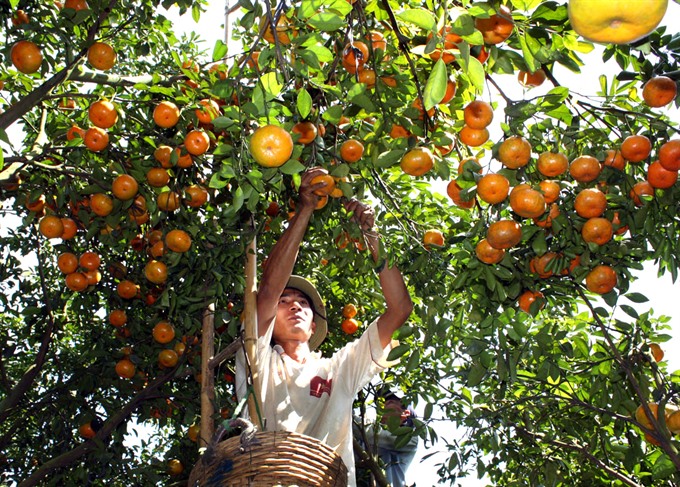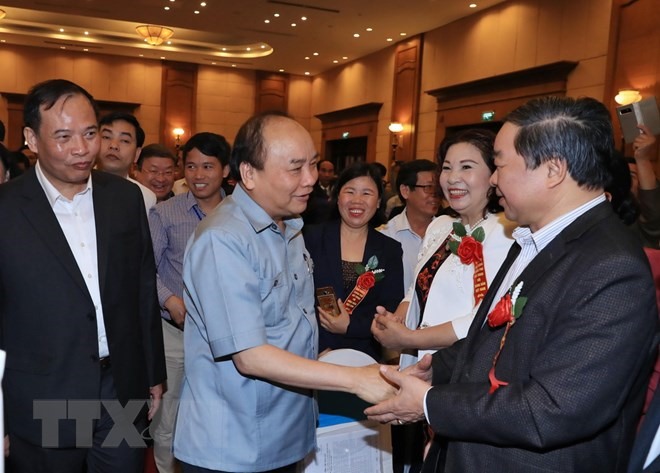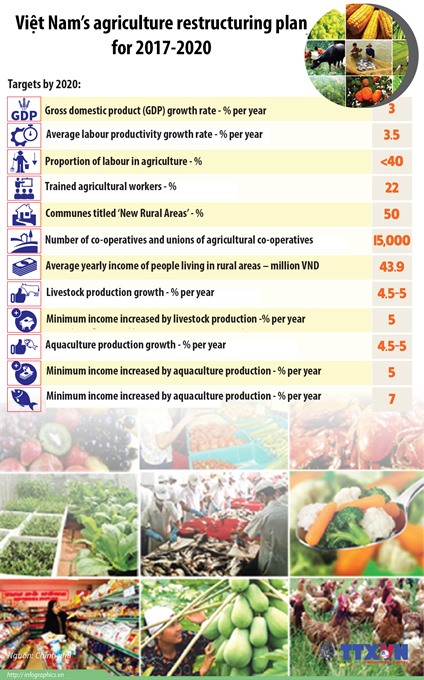 Society
Society

Prime Minister Nguyễn Xuân Phúc, for the first time on Monday, joined an official dialogue with farmers across Việt Nam to listen and respond to their problems.
 |
| A man harvesting tangerine, a signature fruit of Lai Vung District, the southern province of Đồng Tháp. — VNA/VNS Photo Nguyễn Văn Trí |
HẢI DƯƠNG — The Government would continue to seek markets for Vietnamese farming products, Prime Minister Nguyễn Xuân Phúc said as he, for the first time on Monday, joined an official dialogue with farmers across Việt Nam to listen and respond to their problems.
In fact, Vietnamese farming products had arrived in major markets, but farmers and producers needed to “catch” the market signal and understand the market demand and consumers’ taste, said the Prime Minister at the dialogue which took place in the northern province of Hải Dương with some 600 participants, including farmers, Cabinet ministers, scientists, researchers and agricultural businessmen.
Phúc said Việt Nam’s agriculture had achieved many milestones but that they were not enough.
“Việt Nam’s agriculture has the potential to develop further. Remaining problems must be addressed to boost the development in agricultural and rural areas, especially to improve the lives of farmers,” he said.
He hoped the dialogue would help farmers by answering their queries, directly solving their problems, or at least, helping the Government to design proper policies.
Nearly 1,000 questions were prepared for the dialogue and classified into four main topics: agriculture market, policies on agriculture finance and farming land, technology and agricultural material management, and rural labour and new rural area models.
 |
| PM Nguyễn Xuân Phúc met participants in the first-ever dialogue among Prime Minister, Government cabinet, outstanding farmers and agriculture bussinessmen on Monday morning in northern province of Hải Dương. — VNA/VNS Photo Thống Nhất |
Tăng Xuân Trường, a farmer from Gia Lộc District in Hải Dương Province, said it was sad to see farmers throw away their products from bumper crops due to dropping prices.
Trường produces and exports farming equipment. He said if his clients wanted high volume of products, he would be unable to supply because of modest production. He was concerned about policies for high-tech farms and improving the capacity of agricultural co-operatives.
Phúc said “The phenomenon of bumper crops but dropping prices happened in particular localities and to particular products. That is not the whole picture of Việt Nam’s agriculture”.
He said the Government was amending and completing its Decision No 210 on attracting investors to agriculture, which was expected to create a driving force for its stronger and sustainable development.
He further said the State and Government would continue to seek markets for Vietnamese farming products. In fact, he said, Vietnamese farming products had arrived in major markets, but farmers and producers needed to “catch” the market signal and understand the market demand and consumers’ taste.
“Before sowing, we must know how much to sow and to whom to sell the products,” he said.
Phúc also emphasised the need to boost food processing. Việt Nam currently has eight food processing plants.
“Processing helps increase the value of the products and actively adjust to the market,” he said.
Shrimp farmer Đặng Thị Dịu from Quảng Ninh Province said farmers faced difficulties in finding markets for their products because they lacked knowledge of the market.
“Can the Government provide better market information and orientation for farmers?” she asked.
Agriculture Minister Nguyễn Xuân Cường, who was also present at the dialogue, said Vietnamese farmers not only fed the Vietnamese population but also exported worth US$30 billion last year.
“Việt Nam is restructuring its agriculture to make it more visible on the global map. In general, Việt Nam’s agriculture is ranked 18 in the world,” Cường said, adding that for Vietnamese products to go further, it was necessary to promote the production and supply chains, including farmers, processors, distributors, exporters and importers.
Nguyễn Công Thừa, head of Anh Đào Cooperative in Đà Lạt City, said his cooperative had produced high-quality products which could not compete with fake products from China because consumers failed to distinguish authentic products from fake ones.
Cường said it was important to improve the criteria and standards to assess farming product quality as well as raise public awareness about the issue.
 |
| VNA/VNS Infographic |
In addition to anti-smuggling/counterfeiting measures, relevant agencies should promote communication, support producers to develop branding and product origin tracking as well as expand the domestic market in line with the national campaign “Vietnamese use Vietnamese products”.
Another issue highlighted in the dialogue was the difficulty faced by farmers and businessmen in accessing bank loans to expand their production.
Đào Minh Tú, deputy governor of State Bank of Việt Nam, said the Government always prioritised funding agriculture and support policies. As an example, he cited the yearly interest rate of short-term loans, which was 7 per cent for agriculture and rural areas, 1-2 per cent lower than that of other loans.
He said since 2013, the interest rate has been reduced to half, from 14 per cent in 2013 to 6.5 per cent now. This is a positive move aimed at reducing the cost for farmers and businesses.
The Government is amending Decision No 55, which will increase loans to fit the characteristics of agriculture production and crops. More preferential loans will be given to hi-tech agriculture, Tú said.
He, however, said banks could not give loans if borrowers did not show accountability and effective use of the lending amount.
Regarding the concern over collateral, Tú said according to newly-issued Circular 59, to get a loan, collateral was no longer the primary condition. If borrowers can prove their money flow and effectiveness of the spending, they can get loan without collateral, he said.
Until now, loans for agriculture, farmers and development of rural areas were over VNĐ1.3 quadrillion (US$57 billion), accounting for 22 per cent of the total loans in Việt Nam’s economy. The value of loans for agriculture, farmers and rural areas increased 20 per cent yearly, which proved the Government’s increasing attention to these areas. — VNS




